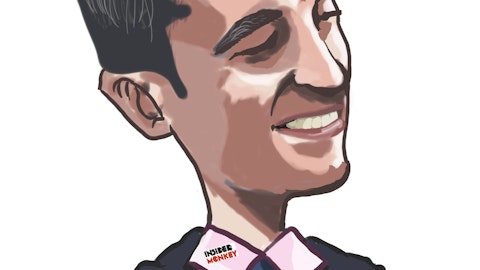Community Health Systems, Inc. (NYSE:CYH) Q4 2022 Earnings Call Transcript February 16, 2023
Operator: Good day, and welcome to the Community Health Systems Fourth Quarter 2022 Earnings Conference Call. Please note that this event is being recorded. I would now like to turn the conference over to Ms. Shelly Schussele, Senior Director of Investor Relations. Please go ahead, ma’am.
Shelly Schussele: Thank you, Chuck. Good morning, and welcome to Community Health Systems fourth quarter 2022 Conference Call. Joining me on today’s call are Tim Hingtgen, Chief Executive Officer; Kevin Hammons, President and Chief Financial Officer; and Dr. Lynn Simon, President of Clinical Operations and Chief Medical Officer. Before we begin, I would like to remind everyone this conference call may contain certain forward-looking statements including all statements that do not relate solely to historical or current facts. These forward-looking statements are subject to a number of known and unknown risks, which are described in headings such as Risk Factors in our annual report on Form 10-K and other reports filed with or furnished to the Securities and Exchange Commission.
As a consequence, actual results may differ significantly from those expressed in any forward-looking statements in today’s discussion. We do not intend to update any of these forward-looking statements. Yesterday afternoon, we issued a press release with our financial statements and definitions and calculations of adjusted EBITDA and adjusted EPS. We have also posted a supplemental slide presentation on our website. We will refer to those slides during this call. All calculations we will discuss exclude gain or loss from early extinguishment of debt, impairment expense, as well as gains or losses on the sale of businesses, expense from government and other legal matters and related costs, income or expense from the settlement of professional liability claims for which the third-party insurers obligation to ensure the company for the underlying loss has been settled, expense related to employee termination benefits, and other restructuring charges, gain from CoreTrust transaction, a sale of equity interest in Macon Healthcare LLC, and change in estimate for professional claims liability related to divested locations.
With that said, I will turn the call over to Tim Hingtgen, Chief Executive Officer.
Tim Hingtgen: Thank you, Shelly. Good morning, and welcome to our fourth quarter conference call. Before we begin, I would like to take a moment to express our heartfelt sorrow for the loss of our friend and colleague, Ross Comeaux. Ross served as our Vice President of Investor Relations from 2016 until his passing last month. Many of you knew Ross personally and appreciated his work to build strong relationships with our shareholders and the analysts who cover our company. For those of us who work closely with Ross, this is a tremendous loss. He was a dedicated son, brother, husband, and father. Our deepest sympathy goes out to his entire family and all who called Ross, a friend. Now, turning to our fourth quarter and year-end results.
2022 was challenging and in many ways, a pivotal year for health care providers in terms of our work to rebuild volumes as the pandemics is sided, stabilize our workforce, and offset inflationary pressures. At CHS, we made considerable progress in each of these areas, especially during the second half of the year. Let me start with volume. We finished the fourth quarter with our strongest volume performance of the year and that was true across all key volume categories. Same-store admissions increased by 4.4% on a year-over-year basis, 2.3% sequentially, and at 99% of our 2019 pre-COVID baseline. COVID-related inpatient admissions were 3% of total admissions, compared to 8% in the fourth quarter of last year. Our focus on expanding outpatient access, as well as capturing surgery and procedural cases that have shifted from inpatient to outpatient classification resulted in a same-store adjusted admissions increase of 8.2% year-over-year and exceeded the 2019 baseline.
Same-store surgeries increased 4.2% from the prior year. 2.5% sequentially and continue to perform above the 2019 pre-COVID baseline. Same-store ED volumes were very strong in the quarter, increasing 8.7% year-over-year, 3.6% sequentially, and finished at 102% of 2019. In the fourth quarter, same-store net revenue declined 1.3%, due largely to the decreased volume of COVID medical admissions in the prior year quarter. However, our focus on building higher acuity service lines continues as demonstrated by further strengthening of our surgical case mix index. Compared to the 2019 baseline, the surgical CMI is now up 3%, despite the large movement of orthopedic cases that have migrated to outpatient classification. We continue to invest in service line development and provider recruitment to further grow acuity across our markets.
Inflationary pressure continues to impact operating expenses and margins, but we made progress reducing contract labor throughout 2022. We have also managed non-labor expenses below inflation. Excluding pandemic relief funds, EBITDA performance was at its highest level in the fourth quarter of the year, in-line with our expectations, as well as historical trends. In addition to the improving operational trends, we extinguished approximately $378 million of notes outstanding during the quarter. We continue to pursue opportunities to lower overall debt and leverage and to improve our capital structure. Kevin will talk about that more in his remarks. Looking ahead, we remain focused on our four priority areas, which we believe remain essential to driving stronger results for our markets and the company.
The first is accelerated growth. Strategic capital investments in access points, outpatient services, and inpatient capacity are enabling near-term volume gains and increasing our potential for long-term growth. We have been consistently investing in our portfolio. Over the last five years, we have added more than 640 new licensed beds, as well as 80 surgical and procedure suites to our existing health systems. Across many markets, we continue to expand our geographic footprint and to increase market concentration with new primary care, specialty care, urgent care, freestanding emergency centers, and ambulatory surgery locations. And provider recruitment remains essential to continuous growth. In 2022, we had our best recruitment year of the past five years.
Our transfer center received a record number of requests for placement last year, which is an important growth driver for the majority of our health systems. Last year, inbound transfers increased 14.5% over the prior year. As we continue to recruit additional staff and further optimize capacity through our length of stay reduction efforts, we expect even more volume from the transfer center, including incremental higher acuity admissions. Our second area of focus includes specific actions to strengthen our workforce. We made very significant progress reducing contract labor during the year and ended 2022 with strong gains in employee recruitment and retention. Contract labor totaled approximately $80 million in Q4, compared to $140 million in the prior year and $100 million last quarter.
Through our company-wide centralized nurse recruitment function, nurse hiring is up 18% for 2022, compared to the prior year. And our retention rates have improved 500 basis points, resulting in a strong net gain in nursing FTEs for the year. Our Jersey College Nursing School relationship expanded with new campuses in Tucson, Arizona and Scranton, Pennsylvania in early January. We now have seven active programs and expect three more to commence in 2023. Our first cohort of students graduated last month in Port Charlotte, Florida, which was a celebratory milestone for those new nurses and for us. When the Jersey College partnership is fully deployed, we expect to graduate approximately 1,000 new nurses each year. Next, our work to control expenses includes our margin improvement program, supply chain initiatives and productivity enhancements.

Photo by National Cancer Institute on Unsplash
During 2022, we made positive strides, including measures to consolidate service lines in some markets, creating greater efficiencies in those health care systems. For 2023, we remain focused on incremental contract labor reduction and other specific tactics to mitigate the inflationary pressures in this operating environment. Finally, our commitment to advance safety and quality is at the heart of everything we do. There are many measures that demonstrate results in this area, but today, I’ll just highlight one. In 2012, CHS hospitals embarked on a journey to create inherently safe health care systems. And now we have a full decade worth of data that shows how much progress we have made. In 2022, we achieved an 87.9% decline in the serious safety event rate from the baseline established 10 years ago.
This equates to thousands of patients who experienced better outcomes as a result of this focus. Our safety program is one of the longest running and most successful in the industry. I want to congratulate and thank our clinicians, support teams, leadership, and everyone at CHS who makes safety their top priority every day. Kevin, at this point, let me turn the call over to you.
Kevin Hammons: Thank you, Tim, and good morning, everyone. As Tim mentioned, we saw meaningful volume recovery and expense management in the fourth quarter and as expected, achieved our highest volume and earnings performance of the year. While lower acuity of inpatient admissions and payer mix changes pressured our top line, the improvements we made in length of stay and contract labor and our management of non-labor expenses below inflation contributed thus having our best EBITDA quarter of the year, excluding pandemic relief funds. Additionally, sequential improvements in same-store net revenue, key volume metrics and EBITDA bode well for us as we begin 2023. In the quarter, we also continued to take advantage of opportunities to improve our capital structure by reducing our debt, while maintaining adequate liquidity.
Moving to fourth quarter results. Net operating revenues came in at $3.142 billion on a consolidated basis. On a same-store basis, net revenue was down 1.3%, compared to the fourth quarter of 2021. This was the net result of an 8.2% increase in adjusted admissions and an 8.7% decrease in net revenue per adjusted admission, which as I mentioned, was pressured by lower acuity inpatient admissions and changes in payer mix, primarily attributable to the Delta wave of COVID experienced during the fourth quarter of 2021, during which we saw a proportionately higher percentage of commercially insured COVID patients during that surge. Adjusted EBITDA was $404 million. During the fourth quarter, we recorded $2 million of pandemic relief funds, compared to $46 million recognized in the prior year period.
Excluding pandemic relief funds, adjusted EBITDA was 402 million, with an adjusted EBITDA margin of 12.8%. As a reminder, we did not include any pandemic relief funds in our 2022 adjusted EBITDA guidance. And going forward, we do not expect to receive or recognize a significant amount of pandemic relief funds from the government. With regard to expenses, on the labor expense side, combined salaries, wages and benefits and contract labor expense improved on a year-over-year basis by approximately $40 million and improved approximately $13 million sequentially. Specifically related to employee costs, we experienced an increase of 4.5% in our average hourly rate for employees on a year-over-year basis. On a sequential basis, base pay inflation grew at approximately 1.5%.
On contract labor expense, we continued our sequential improvement, as well as making significant progress over the prior year. During the fourth quarter of 2022, contract labor was approximately $80 million, compared to $140 million in the prior year quarter. On a sequential basis, in 2022, our contract labor was $190 million in the first quarter, $150 million in the second quarter, $100 million in the third quarter, and $80 million in the fourth quarter. We anticipate continued progress reducing our contract labor throughout 2023, albeit at a slower pace. We have effectively executed several cost reduction initiatives and thus, non-labor expenses continue to trend below inflation. Overall, we experienced a moderate increase of approximately 3% over the prior year, despite a $30 million increase in medical specialist fees, a $40 million increase in malpractice insurance, and $8 million related to Hurricane Ian.
All other increases and decreases in non-labor expenses netted to a reduction of approximately $40 million. We’ve been able to keep the growth of these costs well below inflationary levels due to the commitment and discipline of our employees to execute on our margin improvement program. Turning to cash flows. Cash flows provided by operations were $300 million for 2022, compared to cash used in operations of $131 million for 2021. Excluding the repaid Medicare accelerated payments in 2021, cash flows provided by operations were $950 million for 2021. The timing of certain cash payments prior to year-end and a few expected cash receipts, which did not arrive prior to year-end, impacted our cash flows from operations for the year ended 2022.
We expect these cash inflows to now come in during 2023. Also, due to the timing of certain payments in 2022 that normalize next year, we expect our working capital to improve in 2023. Moving on to CapEx. Full-year 2022 CapEx was $415 million, compared to $469 million in the prior year and was in-line with our expectations. As we mentioned on last quarter’s call, we effectively adjusted our pace of spending on capital expenditures to reflect the operating environment without materially slowing our growth opportunity. We continue to improve our capital structure through a combination of privately negotiated transactions and open market repurchases. In the fourth quarter, we repurchased $378 million of debt with $171 million of cash, capturing $193 million of discount.
As we look to the full-year of 2022, we took advantage of market conditions in the early part of the year, while interest rates were favorable by refinancing and extending $1.5 million of debt maturities, lowering our interest rate from . And in the second half of the year, we repurchased a total of $645 million of debt for an aggregate cost of $345 million of cash, capturing $300 million of discount. These transactions combined lower our cash interest on an annualized basis by over $58 million. The company’s net debt-to-EBITDA is currently 7.9x, due mostly to the lower EBITDA attributed to the current operating environment. As we manage through this environment, we remain focused on our longer-term goals of lowering our leverage and increasing our free cash flow.
Although we use more of our cash in order to repurchase debt and we experienced lower free cash flows than we anticipated, we retained $118 million of cash on the balance sheet at the end of the fourth quarter and we still have the availability of substantially all of our ABL with $852 million of borrowing base capacity. As a reminder, we have no debt maturities until 2026. As we previously mentioned, we continue to have interest from outside parties related to potential divestitures, and we are also assessing opportunities to add to our portfolio. As these opportunities emerge, we analyze the future growth and earnings profile of specific assets and assess the impact potential transactions would have on our future financial leverage and free cash flow generation.
During the quarter, we received $85 million of cash proceeds for the sale of one facility in West Virginia, which closed on January 1, 2023. And we also signed an agreement to sell our last remaining facility in West Virginia, which we expect to close on March 31, 2023. We remain engaged in continuing discussions about other potential transactions. We believe these transactions, if they come to fruition, will provide opportunities to further pay down debt, as well as allow opportunities to reinvest resources to areas of our portfolio to advance their long-term growth in earnings. Now, I will walk through our full-year 2023 guidance. Net operating revenues are anticipated to be $12.2 billion to $12.6 billion. This represents a 4% to 6% growth in same-store net revenue.
Adjusted EBITDA is expected to be $1.475 billion to $1.625 billion. Net loss per share diluted is anticipated to be a $0.65 loss to a $0.05 loss per share based on weighted average diluted shares outstanding of 130 million to 131 million shares. Cash flow from operations are anticipated to be $675 million to $825 million. CapEx is expected to be $450 million to $500 million and cash interest is expected to be $760 million to $780 million. In summary, we are optimistic about 2023. We expect to accelerate our growth initiatives, strengthen our workforce in advanced safety and quality, while leveraging expense management to drive positive financial results and free cash flow. We remain committed to our objectives, which are designed to position the company for long-term and sustainable success and are focused on the opportunities, which lie ahead for us.
Shelly, at this point, I’ll turn the call back over to you.
Shelly Schussele: Thank you, Kevin. At this point, Chuck, we’re ready to open the call for questions.
See also 11 High Growth IT Stocks to Buy and 10 Largest Economies in Europe.
Q&A Session
Follow Community Health Systems Inc (NYSE:CYH)
Follow Community Health Systems Inc (NYSE:CYH)
Operator: Yes ma’am. And the first question will come from Brian Tanquilut with Jefferies. Please go ahead.
Unidentified Analyst: You have on for Brian. I just want to say congrats on the quarter. So, I think I’ll go ahead and touch on contract labor. Clearly, you’re executing well on this front. Just wanted to know what’s driving the sequential improvement? And can you quantify how much more space do you think you have to bring that down this year? Thanks.
Kevin Hammons: Sure. Thank you for the question, and I can start that off. And Tim, there’s something else I missed. Please feel free to jump in. Early in 2022, we began our centralized recruiting efforts for nursing. And by April, we had all of our hospitals, kind of rolled into that centralized recruiting effort. Doing so has really allowed us to improve and expand our ability to bring in new employed nurses, which ultimately has been the hurdle of being able to take out contract labor. So, as we’ve made progress, and I believe our nurse recruiting is up 18% year-over-year in 2022, that has allowed us to take out contract labor and reduce those costs, albeit at a significantly lower cost to the company. As we go forward in 2023, certainly, the pace of reduction is going to come down.
If you think about fourth quarter in first quarter historically has been higher quarters for utilization and contract labor, particularly around our markets in Florida, where we have more seasonality, but I would expect this ultimately when things level out to be somewhere in the $50 million to $60 million per quarter on average range for contract labor. So, I think we have some room, although I think it still takes a little time for us to get down there in the current environment.
Unidentified Analyst: Thanks.
Operator: The next question will come from Josh Raskin with Nephron Research. Please go ahead.
Josh Raskin: Hi, thanks. Sort of a related topic, but a little bit bigger. Just the midpoint of 2023 guidance on a year-over-year basis, grants, EBITDA margin improvement about just under 200 basis points. So, maybe you could help talk to the specific buckets of that improvement be very interested in the SWB line specifically. And then it sounded like you think contract labor may be able to get down to that could be down 150 million to 200 million just my math. I’m just curious if that’s the right ballpark.
Kevin Hammons: Yes. I think you’re absolutely right. I think contract labor, based on full-year of 2022, we had about $520 million of contract labor in our current run rate, even if we stayed flat in 2023, we would see a $200 million reduction in contract labor. I think we’ll make a little more progress in that throughout 2023. So, I would guess it’s $200 million to $250 million year-over-year reduction. Now, some of that does come back to us in terms of salaries and wages as we replace some of the contract labor with employees. I would estimate somewhere in the neighborhood of 30% to 35% of that reduction in contract labor comes back to as employee cost. In terms of inflation on SWB, we’re estimating for 2023, about a 5% inflation rate on the average hourly rate. So that, combined with some additional employees as we take out contract labor would be how you get to SWB estimate for next year.
Josh Raskin: Got you. And then could you just remind us what was the total EBITDA contribution, if it was positive for the facilities that were divested in 2022 and maybe, including the one that closed on ?
Kevin Hammons: Yes. Overall, for the facilities that were closed, divested and I would also lump in some of the consolidated services and service line closures probably had a net a small net negative contribution during 2022. So, those should be accretive going into 2023.
Josh Raskin: Okay. So, slightly accretive. Okay. Thank you.





